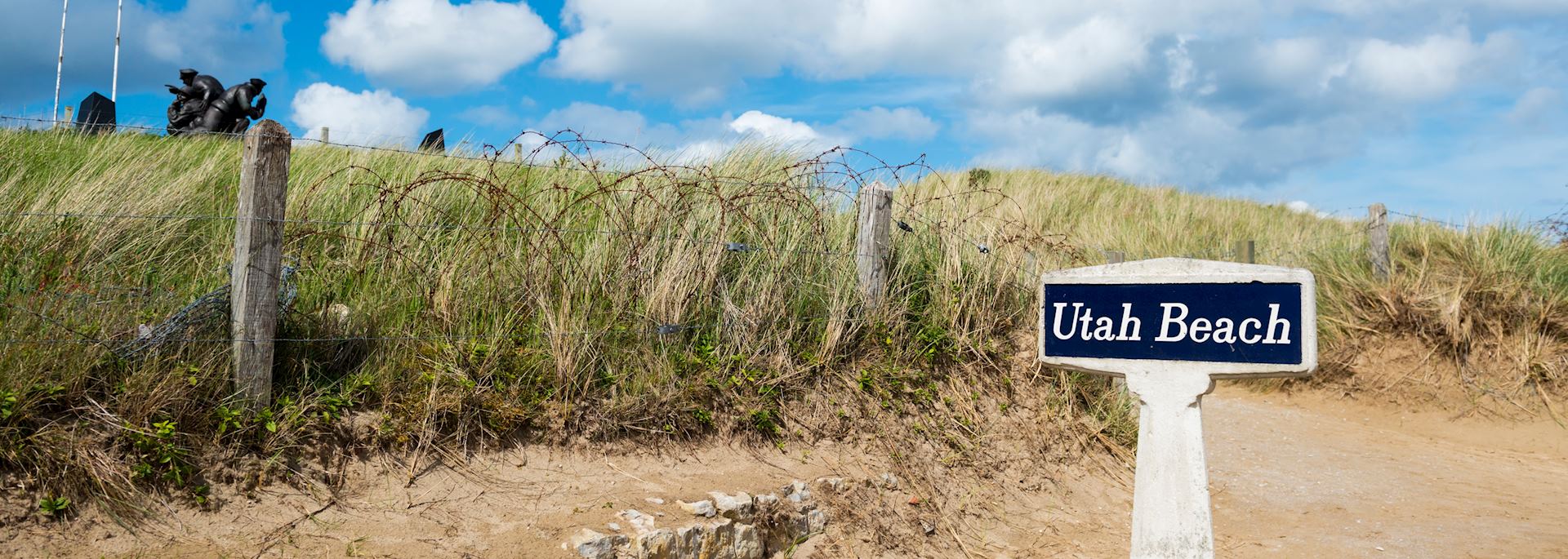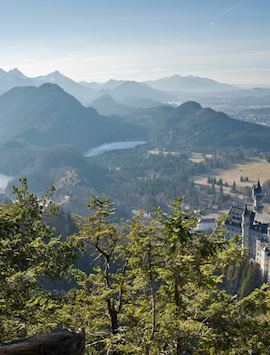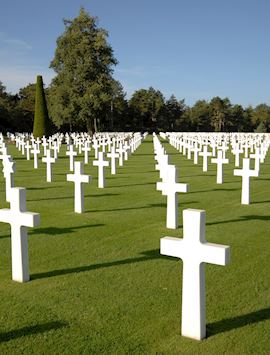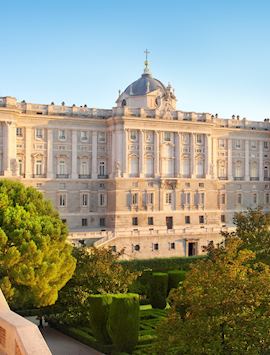In London, shrapnel damage still pocks the walls of the Victoria & Albert Museum, and in Normandy, whole fields remain scalloped by craters from the D-Day invasion. In ways large and small, World War II has left its mark on the people, countries and landscapes of Western Europe.
Whether you want to add a few war-related sites to your trip or plan an entire itinerary based around military history, we’ve created a guide to some of Western Europe’s most impressive World War II sites for you. In addition to blockbuster sites like Churchill’s War Rooms and the Normandy beaches, we’ve also included smaller, lesser-known options like the Bourbon Tunnels in Naples.
Submarines and secrets in Liverpool, UK
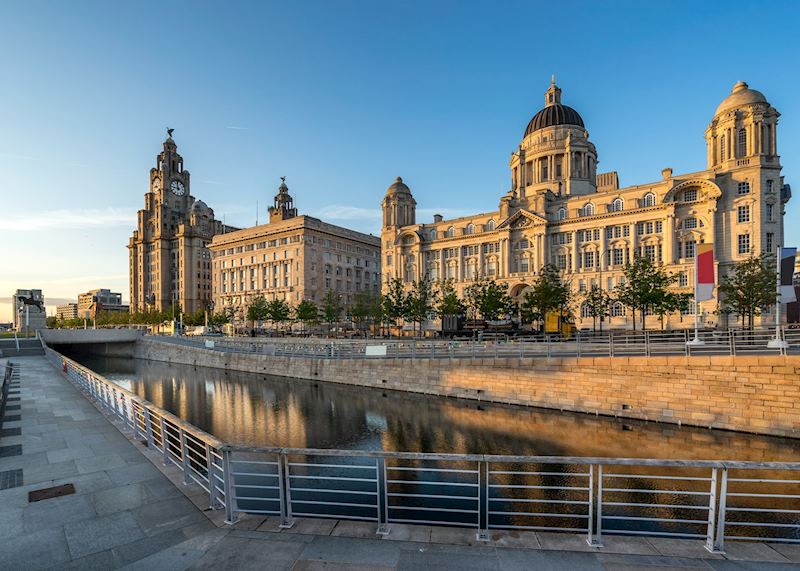
Though it’s best known for its musical history, Liverpool played an essential role in the war’s naval areas. The island nation was dependent upon convoys bringing in supplies from the Atlantic and those ships were protected by the massive, complex operation at the Western Approaches.
Left almost exactly as they were when the office closed in August 1945, the museum’s Map Room includes a huge world map, marked in white gridlines. Here, personnel plotted out the movement of ships like a huge, high-stakes game of Battleship, with real lives at risk. A visit here gives you a glimpse into the beating bureaucratic heart of the Allied operations during the Battle of the Atlantic.
This HQ played a complicated game of hide and seek with the many U-boats that prowled the Atlantic, hunting convoys in so called ‘wolf packs’. At the U-Boat Experience, located across the River Mersey from the museum, you can also look inside U-534, one of just four surviving German submarines that’s been preserved. Its rust-streaked exterior hints at the cramped, grim conditions that sailors on both sides had to contend with.
Churchill’s War Rooms and the Imperial War Museum, London
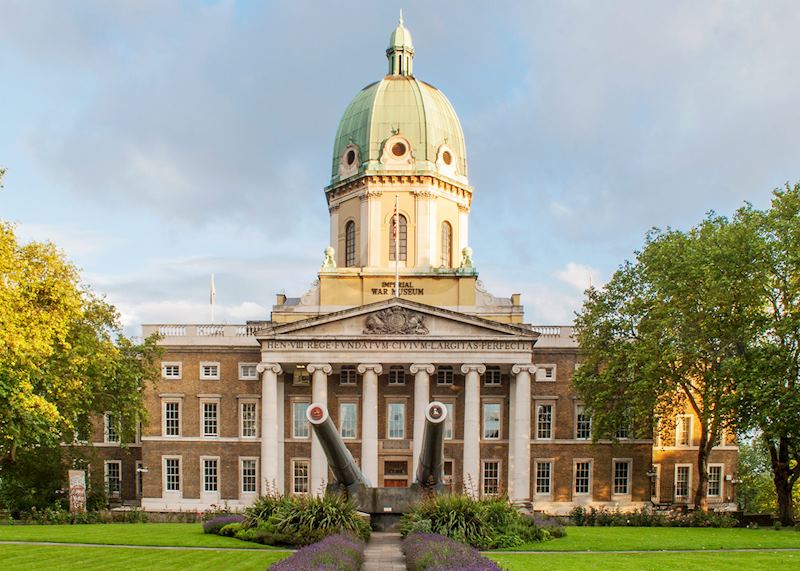
Even in a teeming metropolis like London, you can still see the scars of the war. On the Victoria & Albert Museum, for example, shrapnel from the Blitz took big bites out of the stone walls — the marks are carefully preserved and annotated with a plaque.
But the inarguable highlight of any World War II-themed trip to London is Churchill’s War Rooms. Technically part of the Imperial War Museum, it carefully preserves the underground complex that housed British command during the war, including those deadly months during the Blitz.
These spartan, joyless rooms, left as they were at the war’s end, might seem familiar because they’ve been reproduced endlessly in movies and television, down to the gleaming black Bakelite phone that Churchill used. However, a private guide can provide a fresh perspective on the headquarters.
Look for the special ‘noiseless’ typewriters that Churchill had imported from the States because he preferred a quiet working environment. You can also see a weather indicator sign, intended to convey the conditions upstairs to the isolated workers toiling away in the bunker. During particularly heavy bombing days, George Rance (an official of the Office of Works) would set it to ‘windy’.
Churchill located his command facility near Saint James Park, close to 10 Downing St, but the main bulk of the Imperial War Museum is located on the other side of the river. Set in what was once Bedlam Hospital, the museum focuses on 20th-century conflicts and the British and Commonwealth troops who fought and died in them.
The World War II exhibits here are comprehensive and often harrowing. You’ll see a German V2 Rocket and a gleaming silver Spitfire that survived the Battle of Britain, its sleek silhouette easy to pick out among the sharp angles of the atrium’s ceiling.
The museum goes well beyond the basic weapons, delving deep into the human cost of the war. One exhibit follows a real family throughout the duration of the war, and another looks at the strange-but-true aspects of espionage and counterintelligence. Perhaps the most gut-wrenching is the Holocaust exhibition, which documents the atrocities of the genocide through photos, film and objects.
Castle, cliffs and tunnels in Dover, UK
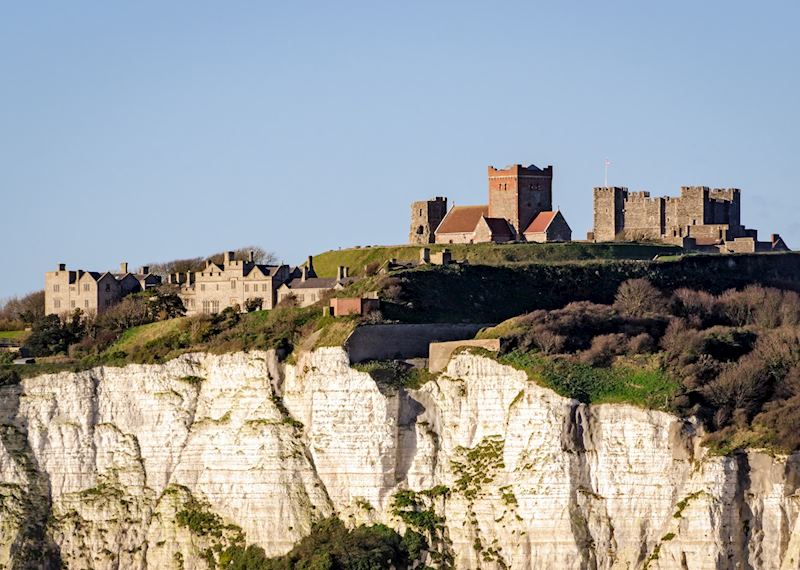
Imposing Dover Castle stands sentinel over the white cliffs that mark the narrowest point in the English Channel. Parts of this square-shouldered fortress date to the 12th century, though there have been fortifications here since the Romans.
Underneath the castle complex, carved out of the soft chalk, you’ll find a network of no-longer secret tunnels that were first created during the Napoleonic Wars. They were converted into an air raid shelter in 1939 and expanded the next year to include a secure underground hospital and Combined Operations Headquarters. Churchill himself stood on a balcony, overlooking the strait, during the Battle of Britain.
The tunnels can seem tight and very dark, the gloom barely pierced by the period-accurate lighting and, in a few places, some parsimonious windows. A tour focuses on Operation Dynamo, the rescue operation to save the soldiers stranded at Dunkirk. With immersive sound effects, projectors throwing light, and the appearance of flames on the tunnel walls, it’s a compelling tour that can be overwhelming for some.
The beaches at Normandy
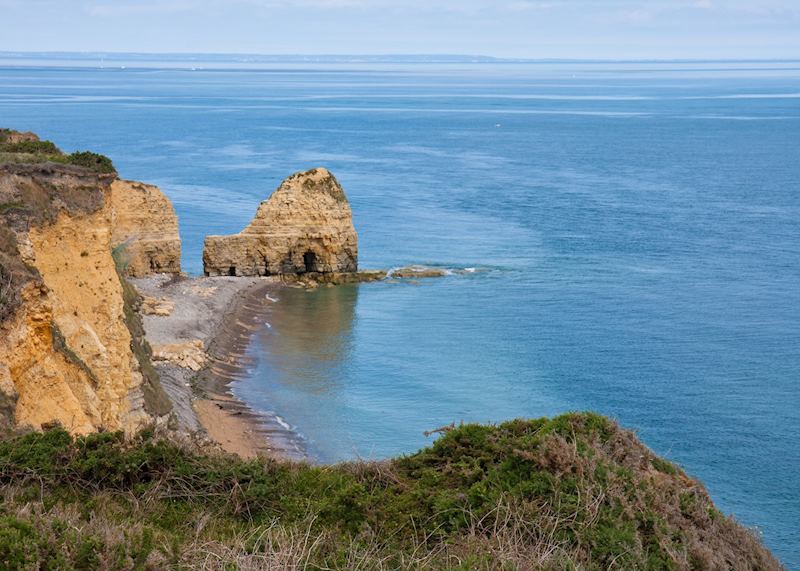
Even though the landings at Normandy have been depicted in films, it’s very different to see it in person. Standing there, on the wide golden sands at Omaha or looking down at the sheer cliffs of Pointe-du-Hoc, can give you a visceral understanding of the odds the Allied forces faced during this pivotal battle.
Plan for at least three days to see everything associated with the war, including the museums, the cemeteries, the artificial ports and the American, British and Canadian landing sites.
A private driver-guide is imperative in Normandy. The narrow roads are confusing, so simply navigating the area is a challenge without one. What’s more, a guide can put what you’re seeing into context, offering small details that don’t come from a guidebook or museum. Many of our guides are local to the area and can speak about their parents’ or grandparents’ personal wartime stories.
Paris, home of the French Resistance
The war is everywhere and nowhere in Paris. After the occupation, Parisians worked hard to erase the remnants of the war from their capital city, so you won’t find many scars from bombing or other obvious signs. However, in a city of 130 museums and countless monuments, you’ll find several dedicated to different facets of World War II.
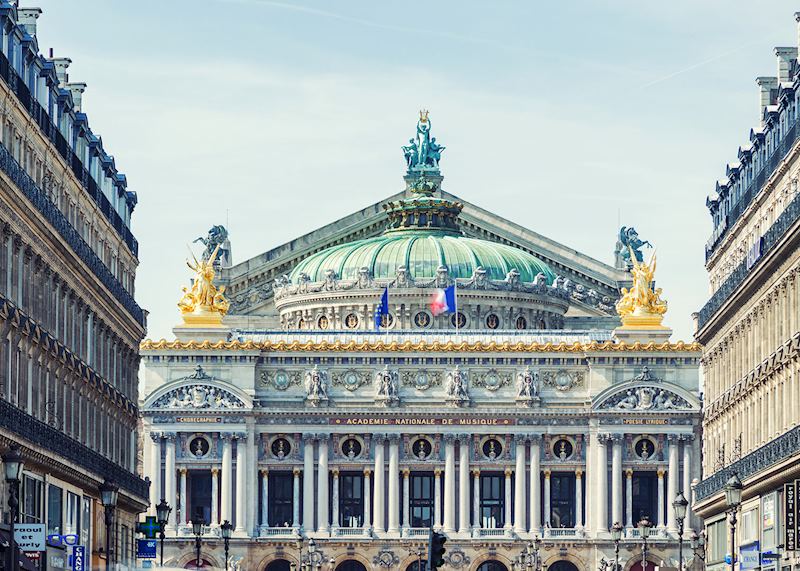
Musée de l’Armée at Les Invalides examines all of France’s military conflicts with a large, permanent exhibit dedicated to World War II. The sheer size and scope of the museum can be overwhelming, so we suggest a private guide to help you navigate the collection and put the exhibit into context, drawing out details that even those familiar with the history may not know.
Located mostly underground, on the site of a former morgue behind Notre Dame, the Mémorial des Martyrs de la Déportation commemorates the 200,000 French citizens who were deported to concentration camps. For a museum focused specifically on the Jewish experience in France during the war, Mémorial de la Shoah is located in Le Marais, an area that had a large Jewish population in the years before the war.
Away from the formal exhibits, Paris remains much as it was during the war — a city devoted to pleasure. High ranking Nazi officials certainly indulged when they were here, and German command tried to get every soldier a stint in Paris, treating the city as if it was a theme park to boost morale. The military governor of Paris, General von Choltitz, set up his HQ in the elegant palace hotel Le Meurice on the Rue de Rivoli. He also refused Hitler’s command to raze the city in the waning days of the war, seduced by the city’s beauty.
Paris was also the hub of the Resistance and a hotbed of espionage and guerrilla action. On the streets, you’ll occasionally see small, sober plaques commemorating the places where some of those fighters died as they fought for the city’s liberation in August 1944.
Today, you can attend a performance at the Paris Opera House, which was once festooned with swastikas, or take a seat at the Moulin Rouge, which remained open during the war and was popular with soldiers. You can also linger over an espresso at Café de Flore, where Picasso spent much of his time during the war. He not only created busts and paintings, but also wrote a play and sold postcards of his anti-war masterpiece Guernica.
Guernica in Madrid
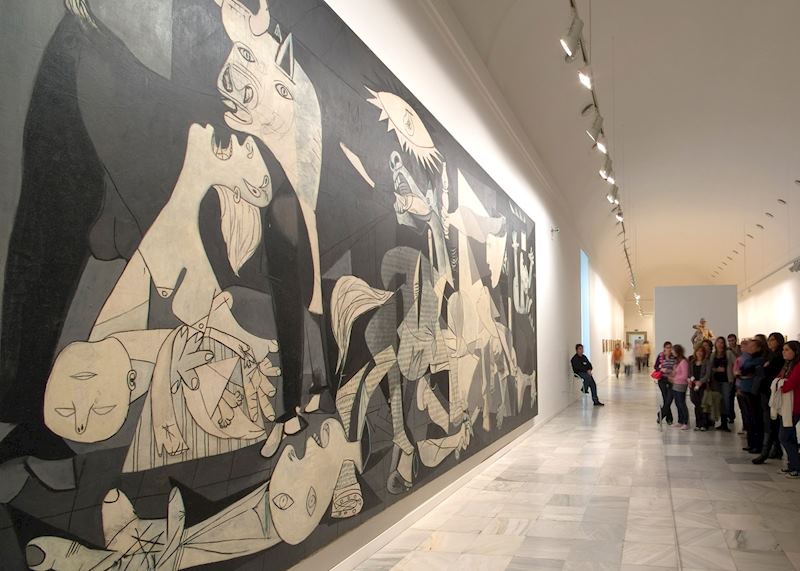
World War II’s dress-rehearsal, the Spanish Civil War left still-gaping wounds both in Madrid and across Spain as a whole. In the Cuidad Universitaria, where the main fighting in Madrid took place, you can still see bullet holes in the buildings along the main avenues and battered Francoist bunkers dotting the forests. Because Franco only died in the 1970s, the war remains fresh in Madrileños’ minds and talking about it is still frowned upon.
Despite that, Madrid is home to one of the era’s most important artworks: the massive and moving Guernica. Painted in 1937, it depicts one of Hitler’s earliest acts of international brutality — the indiscriminate bombardment by the German Condor Legion of the Basque town that shares the painting’s name. The grim, gray-scale work depicts the town’s wholesale slaughter in jagged angles and fractured figures.
The artist himself insisted that the piece not return to his home country until the Spanish people once again enjoyed democracy, a condition that wasn’t fulfilled until 1981. Today, you can see it hanging in grave solitude in a gallery at the Reina Sofía.
Bourbon bomb shelters and vintage cars, Naples, Italy

In the mid-1800s, King Ferdinand II of Bourbon ordered a secret escape tunnel to be built from his Naples palace to a military barracks, in case his fractious subjects rioted. However, the king died before the tunnel was completed.
It was rediscovered in the 1930s, when officials used it as a storage space for impounded cars. Then, once the war began, locals took shelter here from aerial bombardment and parts of the space were expanded and converted to a hospital. After the war, the space became a dumping ground for wartime rubble and fascist monuments.
Today, you can visit the tunnels, which are dark and close, and see the items that have been left here over the years. You’ll see objects left behind by sheltering Neapolitans, including toys and a hairbrush. Ranks of vintage cars slowly moulder into rust, broken bicycle skeletons have turned ghostly pale with dust, and a cracked, nose-less statue of fascist leader Aurelio Padovani leans against a wall, staring off into the darkness.
Read more about trips to Europe
Start thinking about your experience. These itineraries are simply suggestions for how you could enjoy some of the same experiences as our specialists. They're just for inspiration, because your trip will be created around your particular tastes.
View All Tours in Europe